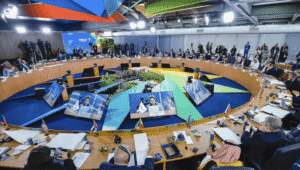The EU can help tackle Europe’s housing crisis by reducing energy costs, decarbonizing buildings and adhering to climate goals.
The European Union has little power when it comes to housing. Housing policy – measures to ensure that there is enough housing of sufficient quality to meet people’s needs – is typically decided on and implemented regionally or nationally. However, a growing housing affordability crisis across Europe has made housing a greater priority at the EU level. For example, housing-related costs have risen since 2010 by about 30 percent, while real household incomes have risen by 20 percent, according to Eurostat. A first European Affordable Housing Plan is planned for publication in December 2025.
The plan will be to “support EU countries and regional and local governments as they seek to deliver affordable and sustainable housing”, according to the European Commission. The Commission measures housing affordability by the ‘overburden rate’, with households that spend more than 40 percent of their disposable income on housing costs considered overburdened. There is no common definition of affordable housing across EU countries (Caturianas et al, 2020).
One area in which the Commission could act, and on which its plan should focus, is decarbonisation of housing. High heating and cooling costs caused by poorly insulated, fossil-fuel-dependent dwellings (Kettel and Wang, 2023) are a factor in housing unaffordability. Energy-efficiency renovations and increased electrification are directly linked to lower household energy expenses and can even improve access to credit for higher-quality homes.
The burden of high energy costs disproportionately impacts low- and middle-income households, which live in the least-efficient dwellings and spend more of their incomes on energy bills. Revenues from the EU Social Climate Fund (SCF) and the emissions trading system for buildings and transport (ETS2) could be directed towards building-decarbonisation schemes to make homes greener and more affordable in the long term.
Decarbonisation supports housing affordability
On average across the EU, energy bills account for five percent and nine percent of household expenditure for low and middle-income families, respectively (Figure 1) , with rural areas bearing a heavier burden. For example, rural households in Poland spend twice as much of their incomes on heating as urban households (Perdana and Vielle, 2026).
Insulation can cut household energy bills by 15 percent to 60 percent (Abdoos et al, 2024), while heat pumps use three to five times less energy than gas boilers. Replacing an efficient gas boiler with a high-performance heat pump can cut energy use by 60 percent to 70 percent, and by up to 90 percent when paired with good-quality insulation (IEA, 2024). Even when electricity prices are more than double gas prices, as is the case in many EU countries, heat pumps are cheaper to run than gas boilers.
A decarbonised building stock would also improve living standards. Three-quarters of EU buildings are categorised as energy inefficient and require excessive energy to provide adequate heating and cooling, relative to modern standards. Energy poverty, defined as the inability to afford essential energy services affects one tenth of European households (Figure 2). Energy-efficiency upgrades reduce energy demand and energy costs, improve thermal comfort and, when paired with clean heating sources such as heat pumps, decrease indoor pollution (Hassan et al, 2024). These gains matter most to low-income households, which often live in the poorest-quality housing.
Challenges to renovation and electrification
Between 2016 and 2020, only 1 percent of EU buildings were renovated per year. Deep renovations that cut primary energy demand by at least 60 percent were carried out only on 0.2 percent of residential buildings per year (Bredahl Jacobsen et al, 2024.
Progress in switching building heating systems to electricity is also insufficient. Only one quarter of buildings in the EU are electrified for heating and cooling (Jugé et al, 2025). The European Commission wants 60 million heat-pump installations by 2030 (European Commission, 2024a) as part of a move to replace 68 million gas and 18 million oil boilers in use in residential buildings. However, while heat pump sales grew during the energy crisis, they slowed in 2024, with sales in Germany halving and those in France falling 25 percent (Figure 3).
Building age, type, ownership and heating systems differ widely across EU countries, requiring tailored policies at national and regional levels (Figures 4-7).
Detached houses dominate in some central and eastern European countries and in rural areas. These require financial and technical support for retrofits and may be particularly suitable for rooftop solar as a decarbonisation option (Hormigos Feliu et al, 2025). Large apartment blocks, meanwhile, need policies that enable collective decision-making, such as loans linked to buildings rather than apartment owners, to finance large-scale renovations.
Tenure patterns differ significantly across countries. In central and eastern Europe, where homeownership rates exceed 80 percent, decarbonisation depends on households’ willingness to invest. Rental markets, such as in Germany and Austria, should have tailored regulatory frameworks, for example giving landlords access to subsidies only if they keep rents affordable. This is critical to overcoming the split-incentive problem, by which landlords are responsible for renovation investments but tenants pay energy bills.
Household energy systems also vary. In most EU countries, gas or oil boilers remain the dominant source of heating, indicating a need for large-scale deployment of heat pumps and scaling up of clean electricity. In regions with widespread district heating, including Denmark, Sweden and the Baltics, the aim should be to decarbonise networks through large-scale heat pumps and integrating renewables and waste heat. Recognising these differences, the EU Affordable Housing Plan should focus on where common action adds real value, funding, standards and shared tools.
EU-level energy rules already contribute significantly to housing policy. The EU set targets for energy savings and on protecting vulnerable households from energy poverty (Directive (EU) 2023/1791) and has obligations on reducing primary energy use in residential buildings (Directive (EU) 2024/1275) and increasing the share of renewables in heating and electricity (Directive (EU) 2023/2413).
Yet, there are several universal barriers to decarbonising buildings, which should be tackled through development and deployment of new policies.
Financial constraints preventing decarbonisation
High upfront costs for energy renovations, long payback periods and volatile energy prices hold up building decarbonisation in Europe (IEA, 2024). Liquidity constraints are particularly severe for low-income households, but even for middle-income families, access to affordable capital is restricted.
Reducing electricity prices is more effective than lowering upfront costs for promoting heat-pump adoption. Electricity makes up 55 percent of a heat pump’s lifetime expenses, covering purchase, installation and operation (Chang et al, 2025). High electricity prices, therefore, give heat pumps less of a running-cost advantage over gas boilers, the lifetime costs of which are mainly driven by gas prices. Most consumers would have a financial reason to switch if electricity prices are no more than twice as high as gas. However, as of the first half of 2025, 19 EU countries had ratios exceeding 2:1 (Figure 9).
Continuous public funding is essential to sustain the decarbonisation of the EU’s building stock. The main EU instrument that supports energy renovation is the post-pandemic economic recovery fund, the Recovery and Resilience Facility (RRF), under which €81 billion has been allocated for building decarbonisation (European Commission, 2024b). The RRF expires in 2026, creating a potential funding gap.
This could be filled, at least partly, from the new EU carbon market (the so-called ETS2) that will apply a carbon price to fuels used for heating and transport. Depending on the carbon price, ETS2 revenues are projected at €342 billion to €570 billion between 2027 and 2032 (Jüngling et al, 2025).
Of these revenues, €87 billion will feed into the EU Social Climate Fund (SCF) to shield vulnerable groups from the distributional challenges of ETS2. The SCF will finance direct income support and investments in energy efficiency, zero-emission mobility and clean heating. But SCF disbursement depends on the timely submission of national Social Climate Plans that outline how EU countries intend to use SCF resources. So far, only Latvia and Sweden have submitted theirs, raising the risk of delays in SCF fund disbursement beyond the planned January 2026 start date.
The remaining ETS2 revenues are earmarked for the green transition in general, but with many competing priorities, countries should ensure sufficient allocation of funding to decarbonisation of buildings. Meanwhile, ensuring that housing and building renovation remain priorities in the next EU budget cycle (2028-2034) will be crucial. EU cohesion funds, which support regional development and reduce inequalities between countries and are allocated and managed at national level, offer another financing channel. Countries should leverage these funds to complement ETS2 and SCF resources for building decarbonisation.
Policy solutions
To be effective, the Affordable Housing Plan should mobilise the right mix of financial and regulatory tools to close the investment gap in building decarbonisation. Despite availability of public money, this gap is estimated at €150 billion per year up to 2030 (Keliauskaitė et al, 2024). Limited public funds should thus be used to stimulate private investment, which is the primary source of financing for energy efficiency (IEA, 2024).
Addressing the upfront investment cost
To maximise impact, public funding should be directed towards policies that lower the upfront costs of renovations and heat pumps. These policy measures must be implemented on a long-term basis to provide stable conditions for investment.
Grants should be prioritised for the worst-performing buildings, which are often occupied by the most vulnerable people. Remaining funds should leverage private investment via green loans, zero-interest loans and pay-as-you-save schemes, allowing households to spread upfront investment costs and repay them from energy savings. Social leasing, with public authorities or companies installing and leasing systems for a monthly fee, could also support heat-pump adoption (Jüngling et al, 2025).
Making electricity cheap and clean
The EU has made limited progress in ending fossil-fuel subsidies. EU state-aid rules still permit support for fossil fuels, including gas and oil. Fossil-fuel subsidies in the EU averaged around €55 billion to €60 billion per year between 2015 and 2021, before doubling to €130 billion in 2022 as governments responded to the energy crisis. In 2023, they remained at €110 billion, with half of these subsidies having no phase-out date. These subsidies distort markets, slow the energy transition and lock in emissions. With declining energy commodity prices, governments need to redirect subsidies from fossil fuels to clean electricity.
In practice, households and small businesses in many European countries pay higher taxes on electricity than on gas. Moreover, in 2023, EU households on average paid 50 percent more per unit of electricity as energy-intensive firms, reflecting differences in how system costs are allocated across consumer groups (Heussaff, 2024). Such pricing structures discourage electrification and make heat pumps less competitive.
Governments could, for instance, adopt time-bound subsidies that link the price of clean fuels to the fossil fuels they replace (McWilliams and Zachmann, 2021). If fossil-fuel prices drop, households would receive a small compensation payment from ETS2 revenues. As carbon prices rise and clean electricity becomes competitive, these payments would be phased out.
Most importantly, countries that rely on gas for electricity generation must expand clean power generation while electrifying their building stock. In several countries (Figure 9), natural gas often sets the marginal electricity price, keeping electricity prices high. Investments in renewables and grid upgrades must keep pace with rising household electricity demand to prevent emissions shifting from domestic gas boilers to fossil-fuel power plants, and to avoid locking households into high energy costs (Heussaff and Zachmann, 2025).
In the Affordable Housing Plan, the European Commission has an opportunity to influence housing affordability by explicitly incorporating building decarbonisation into its affordability strategy, fostering regional cooperation and aligning social and climate policy objectives.
The Commission could also acknowledge that, over time, housing markets are likely to reflect differences in energy performance. Properties with poor efficiency ratings may drop in value as renovation requirements tighten, while new and highly efficient homes could become even more expensive. This underscores the need to make energy renovations accessible to prevent a widening divide in housing affordability.
Source : Bruegel



































































